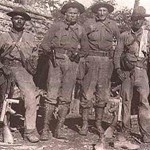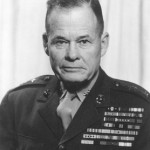
There are not enough Chinamen in the world to stop a fully armed Marine regiment from going where ever they want to go’-Chesty Puller … ( literally every time chesty opened his mouth he uttered a quote here is a source for some of them and if you google it you’ll find more..you’ll be glad that you did)
Rare Footage Of Chesty, see below
Lt.Gen. Lewis B. “Chesty” Puller
June 26, 1898 – October 11, 1971
Chesty Puller enlisted in the Marine Corps in 1918 at the age of 20. He chased bandits in Haiti and Nicaragua. He commanded the Horse Marines in Peking as Commander of the 2nd Btn 4th Marines. In W.W.II he battled his way from Island to Island in the Pacific. He led his Marines at the Landing at Inchon as well as one of the most Savage rearguard actions of the Korean War; The Battle of the Chosin Reservoir.
The story of Lt. Gen. Lewis Burwell (Chesty) Puller
“Our Country won’t go on forever, if we stay soft as we are now. There won’t
be any AMERICA because some foreign soldiery will invade us and take our
women and breed a hardier race!”
-Lt. Gen. Lewis B. “Chesty” Puller, USMC
Lieutenant General Lewis B. “Chesty” Puller was a colorful veteran of the Korean War, four World War II campaigns, and expeditionary service in China, Nicaragua, and Haiti. He was the only Marine to win the Navy Cross five times for heroism and gallantry in combat.
 A Marine officer and enlisted man for 37 years, General Puller served at sea or overseas for all but ten of those years, including a hitch as commander of the “Horse Marines” in China. Excluding medals from foreign governments, he won a total of 14 personal decorations in combat, plus a long list of campaign medals, unit citation ribbons and other awards. In addition to the Navy Crosses, the highest honor the Navy can bestow, he holds its Army equivalent, the Distinguished Service Cross.
A Marine officer and enlisted man for 37 years, General Puller served at sea or overseas for all but ten of those years, including a hitch as commander of the “Horse Marines” in China. Excluding medals from foreign governments, he won a total of 14 personal decorations in combat, plus a long list of campaign medals, unit citation ribbons and other awards. In addition to the Navy Crosses, the highest honor the Navy can bestow, he holds its Army equivalent, the Distinguished Service Cross.
Born 26 June 1898, at West Point, Virginia, the general attended Virginia Military Institute until enlisting in the Marine Corps in August 1918. He was appointed a Marine Reserve second lieutenant 16 June 1919, but due to force reductions after World War I, was placed on inactive duty ten days later. He rejoined the Marines as an enlisted man to serve with the Gendarmerie d’Haiti, a military force in that country under a treaty with the United States. Most of its officers were U. S. Marines, while its enlisted personnel were Haitians.
After almost five years in Haiti, where he saw frequent action against the Caco rebels, Puller returned in March 1924 to the United States. He was commissioned a Marine second lieutenant that same month, and during the next two years, served at the Marine Barracks, Norfolk, Virginia, completed the Basic School at Philadelphia, Pennsylvania, and served with the 10th Marine Regiment at Quantico, Virginia.
In July of 1926, Puller embarked for a two-year tour of duty at the Marine Barracks, Pearl Harbor. Returning in June 1928, he served in San Diego, California, until he joined the Nicaraguan National Guard Detachment that December. After winning his first Navy Cross in Nicaragua, he returned to the United States in July 1931 to enter the Company Officers Course at the Army Infantry School, Fort Benning, Georgia. He completed the course in June 1932 and returned to Nicaragua the following month to begin the tour of duty that brought him a second Navy Cross.
In January 1933, Puller left Nicaragua for the United States. A month later he sailed from San Francisco to join the Marine Detachment of the American Legation at Peiping, China. There, in addition to other duties, he commanded the famed “Horse Marines.” Without coming back to the United States, he began a tour of sea duty in USS AUGUSTA of the Asiatic Fleet. In June 1936 he returned to the United States to become an instructor in the Basic School at Philadelphia. He left there in May 1939 to serve another year as commander of the AUGUSTA’s Marine Detachment, and from that cruiser, joined the 4th Marine Regiment at Shanghai, China, in May 1940.
After serving as a battalion executive and commanding officer with the 4th Marines, Puller sailed for the United States in August 1941. In September, he took command of the 1st Battalion, 7th Marines, 1st Marine Division, at Camp Lejeune. That Regiment was detached from the 1st Division in March 1942 and the following month, as part of the 3rd Marine Brigade, sailed for the Pacific theater. The 7th Regiment rejoined the 1st Marine Division in September 1942, and Puller, still commanding its 1st Battalion, went on to win his third Navy Cross at Guadalcanal.
The action that brought him that medal occurred on the night of October 24-25 1942. For a desperate three hours his battalion, stretched over a mile-long front, was the only defense between vital Henderson Airfield and a regiment of seasoned Japanese troops. In pouring jungle rain the Japanese smashed repeatedly at his thin line, as General Puller moved up and down its length to encourage his men and direct the defense. After reinforcements arrived, he commanded the augmented force until late the next afternoon. The defending Marines suffered less than 70 casualties in the engagement while 1400 of the enemy were killed and 17 truckloads of Japanese equipment were recovered by the Americans.
After Guadalcanal, Puller became executive officer of the 7th Marines. He was fighting in that capacity when he won his fourth Navy Cross at Cape Gloucester in January 1944. There, when the commanders of the two battalions were wounded, he took over their units and moved through heavy machine-gun and mortar fire to reorganize them for attack, then led them in taking a strongly fortified enemy position.
In February 1944, Puller took command of the 1st Marines at Cape Gloucester. After leading that regiment for the remainder of the campaign, he sailed with it for the Russell Islands in April 1944. He went on to command it at Peleliu in September and October 1944. He returned to the United States in November 1944, named executive officer of the Infantry Training Regiment at Camp Lejeune in January 1945, and took command of that regiment the next month.
In August 1946, Puller became Director of the 8th Marine Corps Reserve District, with headquarters at New Orleans, Louisiana. After that assignment, he commanded the Marine Barracks at Pearl Harbor until August 1950, when he arrived at Camp Pendleton, California, to re-establish and take command of the 1st Marines, the same regiment he had led at Cape Gloucester and Peleliu.
Landing with the 1st Marines at Inchon, Korea, in September 1950, he continued to head that regiment until January 1951, when he was promoted to brigadier general and named Assistant Commander of the 1st Marine Division. That May he returned to Camp Pendleton to command the newly reactivated 3rd Marine Division in January 1952. After that, he was assistant at division commander until he took over the Troop Training Unit, Pacific, at Coronado, California, that June. He was promoted to major general in September 1953, and in July 1954, assumed command of the 2nd Marine Division at Camp Lejeune. Despite his illness, he retained that command until February 1955, when he was appointed Deputy Camp Commander. He served in that capacity until August, when he entered the U. S. Naval Hospital at Camp Lejeune prior to retirement.
In 1966, General Puller requested to return to active duty to serve in Vietnam, but was turned down because of his age. He died 11 October 1971 in Hampton, Virginia, after a long illness. He was 73
Author unknown ( source)
